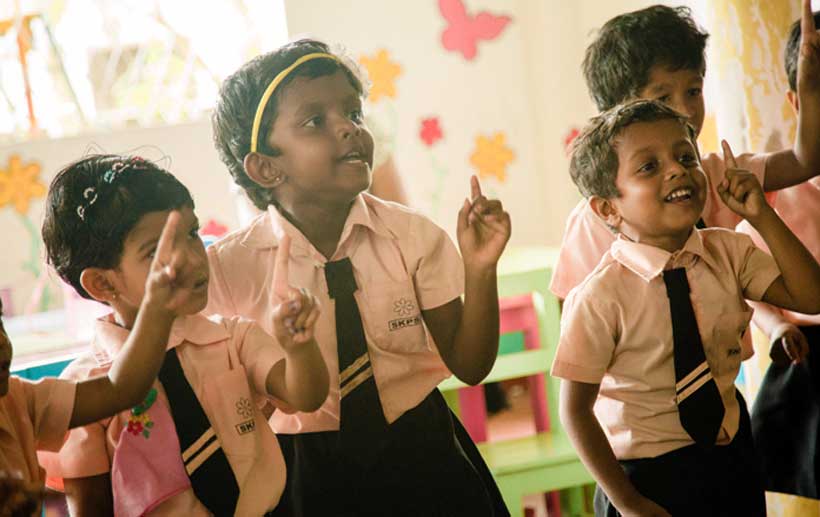Today, Lalani Damayanthi Perera is pretending to be a crow. A teacher at the Singithi Kekulu Pre-school and Day Care Centre, Lalani and her assistant (who is wearing a fox mask) are acting out the classic Aesop fable for a group of 40 Sri Lankan children, all of whom are under the age of five. In the story, the fox uses flattery to trick the crow into dropping a piece of cheese; as Lalani gives out a loud ‘caw’, the children giggle.
Lalani learned how to use drama effectively in the classroom at a training on early childhood development. “Before I used to use only picture cards and books to narrate stories,” she says, explaining that acting is both more fun and more effective. The children can re-tell the story at home, and their recall is improved. “Even if we ask after a month’s period, they remember how the teacher acted.”
Lalani received her training through the first stand-alone Early Childhood Development (ECD) project supported by the World Bank in South Asia. As part of the project, a National Census of ECD centers has helped identify key challenges, including the urgent need to -upgrade facilities and to provide training for teachers, child development officers, and parents of young children.
Promoting early childhood development is promoting equity
Lalani knows that the socio-economic status of families around her plays a big role in whether children are sent to pre-school or not. Some families struggle to scrape together the fees. “The families around our preschool in our village are poor,” says Lalani, adding that many are daily wage laborers employed as masons, carpenters or gardeners.
Lalani’s experience confirms why Sri Lanka must pay special attention to improving access to ECD for children from all kinds of socio-economic backgrounds, in all parts of Sri Lanka.
The latest net enrolment rates for ECD across wealth quintiles reveal how approximately 54 percent of children from Sri Lankan households in the highest quintile are enrolled in preschool, compared to only 44 percent from the lowest quintile. It is clear, even at the highest quintiles, that there is significant room for improvement. Disparities also exist between urban and estate sectors, with 54 percent enrolment in cities, compared to 42 percent in the plantations, according to the latest Sri Lanka Household Income and Expenditure (HIES) data
This is a concern with studies establishing that children from economically disadvantaged families are at a greater risk of poor cognitive development than children from richer households. Early developmental delays can have long-term and potentially irreversible consequences. In this context, access to early childhood education can help equalize learning opportunities, and promote equitable development.
Training programmes should target parents
While the importance of teacher training is widely recognized, more can be done to educate parents about the benefits of early childhood education. Targeted programs not only encourage families to take advantage of the services offered by preschools and other ECD centers, but also to help them to understand their role at home, including how play, early learning and stimulation, and nutrition impact their children.
Beginning in January and going into May every year, Suranjee Udayanganee an Early Childhood Development Officer, gathers groups of parents to conduct awareness programs. One of her big challenges is getting parents to understand that early childhood education is not about academic learning but rather about how play-centered activities and socialization can provide invaluable benefits to their children.
She helps parents identify activities they can do at home, such as helping children recognize shapes, learn songs or identify vegetables. “Parents have to make the environment at home child-friendly,” she says. “This cannot be done by anyone else, cannot be bought for money, or by sending them to tuition classes.”
Suranjee explains that young children learn best from experiences. “They grab fast to what they see and learn from that, so what the child sees in the family and the earliest environment should be positive.”
Sri Lanka needs to invest more in early childhood education
Investing in early childhood development makes economic sense for Sri Lanka, as such interventions have proven to have high benefit-cost ratios as well as the best rate of return on any human capital investment. Children who are exposed to such programmes typically report improved performance on standardized tests, reduced school drop-out rates, and increased grade retention rates.
While recognition of its importance has been growing in Sri Lanka, this recognition has not been matched by increased investment in the sector. Among middle-income countries, the average public expenditure on early childhood education (as a percentage of GDP) is .03 percent. In contrast, Sri Lanka spends just 0.0001 percent of its GDP on early childhood education – one of the lowest ratios of public spending on ECD in the world. In addition, a large percentage of ECE centers lack sufficient basic inputs such as protected drinking water, first-aid boxes, blackboards, toys, scrap materials. When these necessities are provided, children thrive.
As part of the Early Childhood Development project, the World Bank supported the expansion of Lalani’s school. On a visit, Suranjanee points out that the school can now cater to more students, and has also been provided with much-needed teaching materials. “It’s very clear the difference between the condition of this place before and now,” says the Early Childhood Development officer. “There’s the space, more objects for children to use. The surrounding is built to suit the children.”


